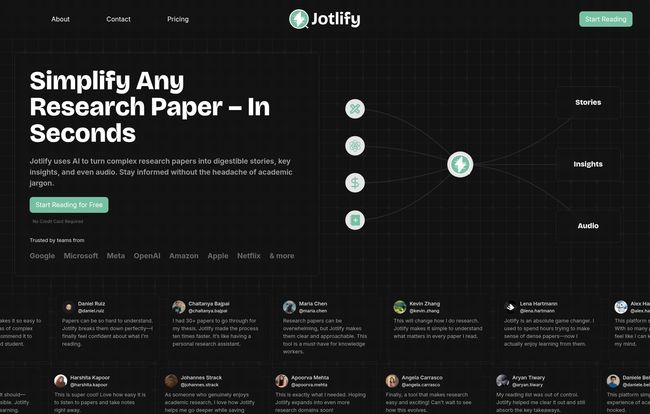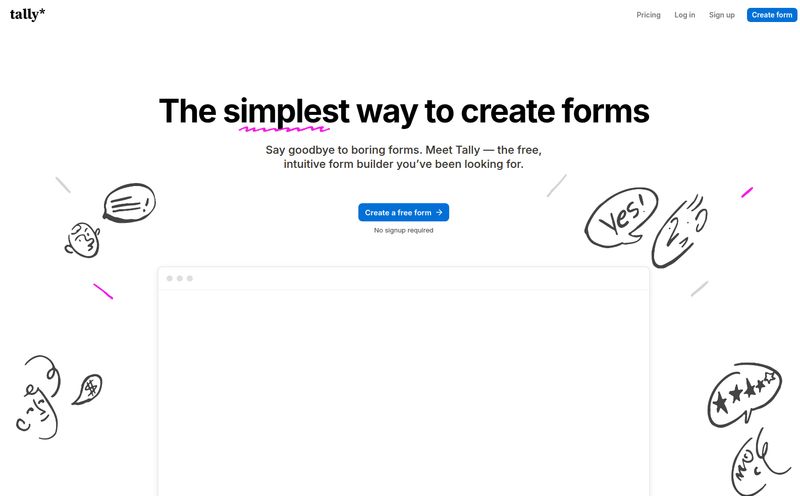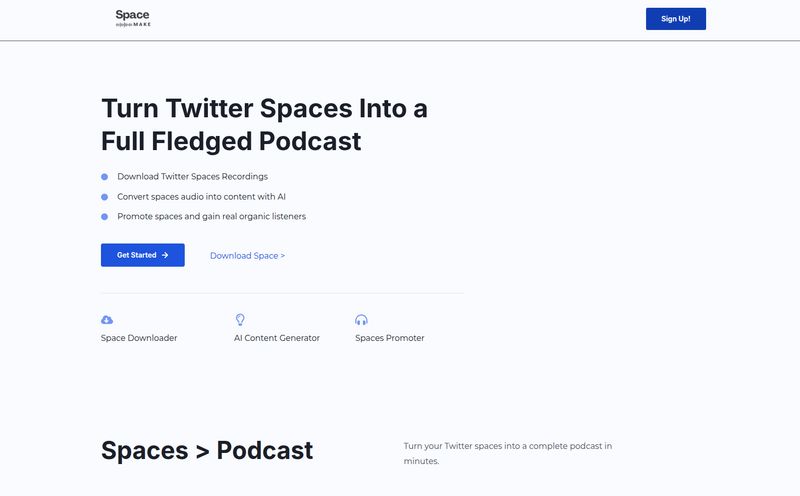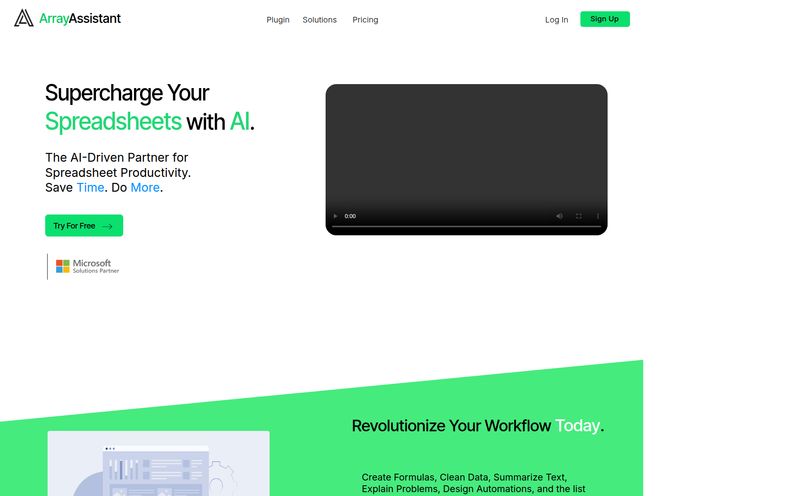As an SEO professional, my life is a constant scramble to stay ahead of the curve. I'm neck-deep in studies about algorithm changes, user behavior reports from Nielsen, and dense white papers on the latest AI trends. And honestly? Trying to read some of them feels like trying to assemble IKEA furniture using only the Swedish instructions. You know there's something brilliant in there, but it's buried under a mountain of jargon, footnotes, and a structure so convoluted it makes your head spin.
I've lost count of the times I've abandoned a promising-looking PDF after the first page, defeated by the sheer density of it all. The abstract promises enlightenment, but the methodology section reads like a different language. It's a universal pain point, whether you're a student, a marketer, an engineer, or just a deeply curious person.
So, when I stumbled upon a tool called Jotlify, which claims it can “Simplify Any Research Paper – In Seconds,” my inner skeptic raised an eyebrow. But my exhausted inner researcher leaned in, whispering, “Please, let this be true.” I decided to take it for a spin, and well, the results were interesting enough that I had to write about it.
So, What Exactly is Jotlify?
Think of Jotlify not just as a summarizer, but as a translator. It’s an AI-powered platform designed to take those intimidating, jargon-filled research papers and transform them into something you can actually understand and use. It turns them into what they call “digestible stories and insights.” And if you’re too busy to even read the story, it’ll create an audio version for you. Yes, you read that right.
It’s like having a brilliant, patient PhD student who has already read the paper, understood it completely, and is now ready to explain it to you in plain English over a cup of coffee. It bridges that massive gap between raw, academic knowledge and practical understanding. The platform claims it’s for everyone, from busy professionals to casual readers, and honestly, after using it, I can see why.
The Academic Struggle is Real
Jotlify’s entire existence is based on a problem we've all faced. They even call it out on their site: Jargon Overload, Clunky Interfaces, Fragmented Sources, and Cumbersome Structure. It’s a perfect storm of frustration.
You find a paper on Google Scholar, another on PubMed, and a third in some obscure university database. You’ve got three browser tabs open, you’re scrolling through tiny PDF text, and every other sentence sends you back to Google to look up a term. Before you know it, an hour has passed and you've retained… basically nothing. It’s not just inefficient; it’s demoralizing. We're living in an age where over 3 million new research papers are published every year. That's a tidal wave of information, and we're all just trying to stay afloat.
A Closer Look at Jotlify's Features
Alright, let's get into the nuts and bolts. What does this thing actually do? I was pleasantly surprised by the focused and genuinely useful toolkit Jotlify offers.
From Dense Text to Clear Stories
This is the core magic trick. You feed it a research paper—either from its library or one you upload—and its AI gets to work. It doesn't just spit out a shorter version of the abstract. It restructures the information into a narrative. It pulls out the key findings, the “so what?” moments, and presents them in a way that makes sense. It felt less like a computer-generated summary and more like well-written cliff notes. This alone is a massive time-saver.

Visit Jotlify
"Listen to Research": Your Commute Just Got Smarter
This feature is, in my opinion, an absolute game-changer. The ability to turn any paper into a podcast-style audio summary is brilliant. I tested this on my way to the gym, listening to a breakdown of a complex study on consumer search intent. Instead of staring at a screen, I could absorb the key insights while on the move. For anyone with a commute, a dog to walk, or chores to do, this transforms dead time into productive learning time. It’s multitasking at its finest.
Ask AI: Your Personal Research Oracle
Ever read a paper and have a specific question that the summary didn't quite cover? Like, “What was the exact sample size of this study?” or “Can you explain the term ‘semi-supervised model’ in simpler terms?” Jotlify’s “Ask AI” feature lets you do just that. You can fire questions at it about the paper you're reading and get crystal-clear answers in seconds. It’s like having a direct line to a subject matter expert, which is incredibly powerful for deepining your understanding.
Bring Your Own Data and Collaborate with Your Team
While Jotlify has a growing library of papers, its real power for professionals and students comes from the ability to upload your own PDFs. Found a crucial paper for your dissertation or a competitor analysis for your marketing team? Just upload it. The platform also has features for sharing your insights and highlights, making it a decent tool for team collaboration. You can convert your findings into shareable cards and invite people to comment in real time. Neat.
Let's Talk Money: The Jotlify Pricing Breakdown
Okay, the all-important question: what's the damage? Jotlify has a pretty straightforward tiered pricing model, which I appreciate. No hidden fees or overly complex plans.
| Plan | Price | Who It's For | Key Features |
|---|---|---|---|
| Reader | $0 /mo | The Curious & Casual Learner | Unlimited reading, 3 audio summaries/month, 3 uploads/month, 10 AI questions/month. |
| Researcher | $15 /mo | Students & Serious Researchers | Everything in Reader, plus unlimited audio, 50 uploads/month, 100 AI questions/month, and note-saving. |
| Researcher Pro | $24 /mo | Professionals & Academics | Everything in Researcher, plus unlimited uploads and AI questions, and the ability to publish your own research on the platform. |
My take? The Free plan is genuinely generous and perfect for anyone who wants to test the waters or just occasionally needs to decipher a paper. The Researcher plan at $15/mo feels like the sweet spot for most dedicated users—students, PhD candidates, and professionals who need to stay informed. The unlimited audio is worth the price of admission alone. The Pro plan is for the power users, the people who live and breathe this stuff day in and day out.
My Honest Take: The Good and The Not-So-Good
No tool is perfect, right? Here’s my balanced perspective after kicking the tires.
What I Love About Jotlify
The biggest win is its sheer simplicity. It takes a genuinely difficult task and makes it accessible. The AI-powered storytelling is more than a gimmick; it fundamentally changes how you interact with dense material. The audio feature is a standout, and the ability to ask follow-up questions provides a depth that simple summarizers lack. It's an elegant solution to a messy problem.
Where It Could Improve
The platform's library seems to initially focus on a few key areas like AI, Health, and Marketing. While you can upload your own stuff, I'd love to see their curated library expand into more niche fields. Also, it’s a subscription service. The best features are, unsurprisingly, behind a paywall. This isn’t really a flaw—they have to keep the lights on—but it's a consideration. The free plan is solid, but you’ll quickly hit the limits on audio and uploads if you use it seriously.
Conclusion: Is Jotlify Your New Research Sidekick?
So, is Jotlify the magic bullet that will slay the dragon of academic reading forever? Maybe not forever, but it's a seriously impressive weapon to have in your arsenal. It successfully lowers the barrier to entry for understanding complex research. It saves time, reduces frustration, and genuinely makes learning more enjoyable.
For students drowning in reading lists, professionals trying to track industry breakthroughs, or anyone who's ever felt intimidated by a research paper, I think Jotlify is absolutely worth a look. Start with the free plan. See if it clicks for you. It might just become the most valuable research assistant you've ever had.
Frequently Asked Questions
- 1. Do I need to create an account to use Jotlify?
- Yes, you'll need to sign up to get started. They have a generous free "Reader" plan that lets you access most of the core features with some monthly limits, so you can try it out without any commitment.
- 2. Can I upload my own research papers to analyze?
- Absolutely! This is one of Jotlify's best features. All plans, including the free one, allow you to upload your own PDF papers for the AI to analyze, summarize, and turn into audio.
- 3. What fields of research does Jotlify cover?
- While you can upload papers from any field, their curated library initially focuses on popular categories like AI, engineering, health, design, marketing, and sales. It's continuously expanding, though.
- 4. How does the "Ask AI" feature work?
- Once you have a paper open, you can use the chat-like interface to ask specific questions about its content. The AI scans the document and provides a direct, contextual answer. It’s perfect for clarifying confusing points or finding specific data without re-reading the whole thing.
- 5. Is the audio summary computer-generated?
- Yes, the audio is generated using text-to-speech AI, but the quality is quite high and sounds natural. It’s designed for easy listening during a commute or workout.
- 6. Can I share my findings with colleagues or classmates?
- Yes, Jotlify includes collaboration features that allow you to convert your highlights and notes into shareable cards and invite others to comment, making it useful for group projects and team-based research.
References and Sources
- Jotlify Official Website
- Jotlify Pricing Page
- arXiv.org - An example of a large, open-access archive for scholarly articles.



